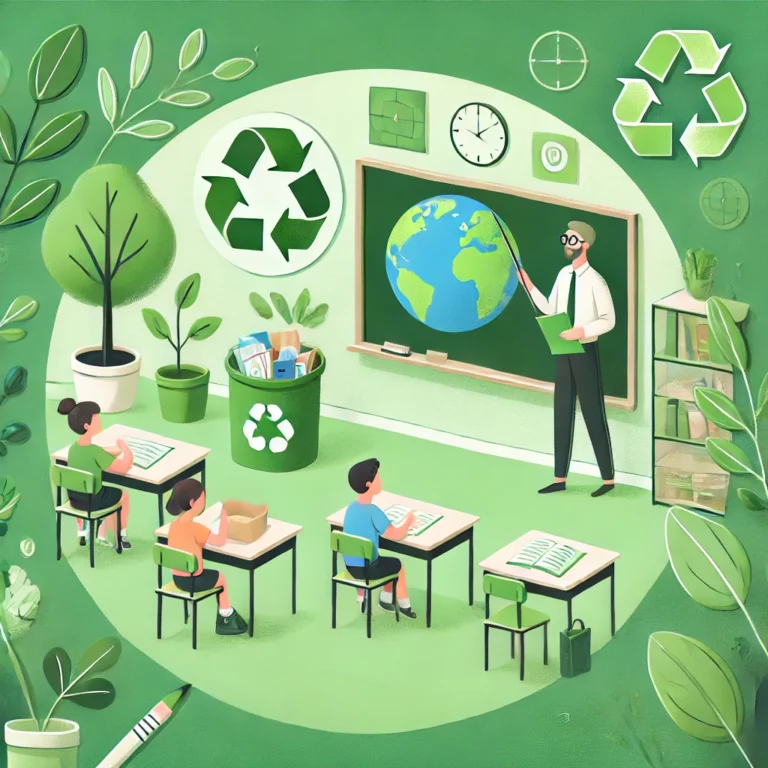With climate change and environmental issues becoming increasingly urgent, it’s more important than ever for teachers to play a role in promoting sustainability and environmental awareness. By integrating sustainability into the classroom, teachers can inspire students to take action and become more mindful of their environmental impact. Here are some practical ways teachers can bring environmental awareness into their classrooms, helping students develop a sense of responsibility for the planet.
1. Incorporate Sustainability into the Curriculum
One of the most effective ways to promote sustainability is by weaving it into the existing curriculum. You can:
- Introduce environmental themes in different subjects: Whether you’re teaching science, math, or even literature, there are ways to connect topics back to sustainability. For example, use science lessons to explain ecosystems, climate change, and renewable energy, or explore environmental literature in language arts.
- Include project-based learning: Encourage students to work on projects related to environmental issues, such as researching endangered species, studying pollution in their local area, or developing ways to conserve energy at school.
By making sustainability part of everyday learning, you help students see the connections between their studies and the real world.
2. Promote Eco-Friendly Practices in the Classroom
Simple changes in daily classroom routines can teach students the value of reducing waste and conserving resources. Some ways to foster eco-friendly habits include:
- Encourage recycling and composting: Set up recycling stations for paper, plastics, and other materials, and teach students how to properly sort their waste. If possible, start a composting project where students can dispose of food scraps.
- Reduce paper use: Go digital whenever possible by using tablets, computers, or interactive whiteboards for lessons. For printed materials, encourage double-sided printing or reusing scrap paper for drafts and notes.
- Turn off lights and electronics: Teach students the importance of conserving energy by turning off lights, computers, and other devices when they’re not in use. Designate a student each day to be responsible for ensuring that energy is not wasted.
Promoting these habits not only reduces the classroom’s environmental footprint but also encourages students to adopt similar practices at home.
3. Organize Eco-Friendly Classroom Activities
Hands-on activities can make environmental learning more engaging and impactful. Some eco-friendly classroom activities include:
- Gardening projects: Start a classroom garden where students can plant vegetables, herbs, or flowers. This teaches them about the life cycle of plants, the importance of soil health, and the benefits of locally grown food.
- Nature walks: Take students outside for nature walks to observe local wildlife, plants, and ecosystems. Use these opportunities to discuss biodiversity, conservation, and the impact of human activity on the environment.
- Upcycling crafts: Encourage creativity by using recycled materials for arts and crafts projects. Students can turn old bottles, cans, and cardboard into art, showing them that trash can be transformed into something new and beautiful.
These activities not only make sustainability fun but also provide students with practical skills they can apply in everyday life.
4. Engage Students in Sustainability Challenges
Creating challenges or competitions around sustainability can motivate students to take environmental action. Some ideas include:
- Waste reduction challenges: Have students track how much waste they produce and work together to reduce it. You can even turn it into a school-wide competition where classrooms compete to produce the least amount of waste.
- Energy-saving competitions: Challenge students to come up with ways to save energy at school and at home. The class that reduces energy consumption the most could win a prize or recognition.
- Eco-friendly behavior awards: Recognize students who consistently demonstrate eco-friendly behavior, such as recycling, using reusable water bottles, or coming up with creative sustainability ideas.
These challenges give students a sense of accomplishment and show them that small actions can have a big impact on the environment.
5. Raise Awareness About Global Environmental Issues
While local sustainability efforts are important, it’s also crucial for students to understand the global nature of environmental challenges. Teachers can:
- Teach about climate change: Provide students with age-appropriate information on climate change, its causes, and its effects. Use documentaries, news articles, or guest speakers to help students grasp the urgency of the issue.
- Discuss environmental justice: Highlight how environmental issues disproportionately affect marginalized communities. This can lead to discussions about fairness, equity, and the importance of advocating for policies that benefit all people.
- Encourage activism: Inspire students to get involved in environmental activism by writing letters to local government officials, attending environmental events, or joining youth-led climate movements.
By raising awareness of global environmental issues, teachers empower students to become informed, engaged citizens who care about the future of the planet.
Sustainability in education goes beyond recycling bins and turning off lights—it’s about instilling a sense of responsibility and environmental stewardship in the next generation. By incorporating sustainability into the curriculum, promoting eco-friendly practices, and engaging students in hands-on activities, teachers can make a lasting impact on their students and the world. When students learn to care for the environment, they are better prepared to tackle the challenges of the future.


